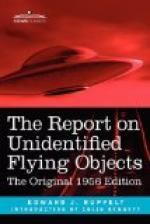Project Sign ended 1947 with a new problem. How do you collect interplanetary intelligence? During World War II the organization that was ATIC’s forerunner, the Air Materiel Command’s secret “T-2,” had developed highly effective means of wringing out every possible bit of information about the technical aspects of enemy aircraft. ATIC knew these methods, but how could this be applied to spaceships? The problem was tackled with organized confusion.
If the confusion in the minds of Air Force people was organized the confusion in the minds of the public was not. Publicized statements regarding the UFO were conflicting.
A widely printed newspaper release, quoting an unnamed Air Force official in the Pentagon, said:
The “flying saucers” are one of three things:
Solar reflections on low-hanging clouds.
Small meteors that break up, their crystals catching the rays of the sun.
Icing conditions could have formed large hailstones and they might have flattened out and glided.
A follow-up, which quoted several scientists, said in essence that the unnamed Air Force official was crazy. Nobody even heard of crystallized meteors, or huge, flat hailstones, and the solar-reflection theory was absurd.
Life, Time, Newsweek, and many other news magazines carried articles about the UFO’s. Some were written with tongue in cheek, others were not. All the articles mentioned the Air Force’s mass-hysterical induced hallucinations. But a Veterans’ Administration psychiatrist publicly pooh-poohed this. “Too many people are seeing things,” he said.
It was widely suggested that all the UFO’s were meteors. Two Chicago astronomers queered this. Dr. Gerard Kuiper, director of the University of Chicago observatory, was quoted as flatly saying the UFO’s couldn’t be meteors. “They are probably man-made,” he told the Associated Press. Dr. Oliver Lee, director of Northwestern University’s observatory, agreed with Dr. Kuiper and he threw in an additional confusion factor that had been in the back of many people’s minds. Maybe they were our own aircraft.
The government had been denying that UFO’s belonged to the U.S. from the first, but Dr. Vannevar Bush, the world-famous scientist, and Dr. Merle Tuve, inventor of the proximity fuse, added their weight. “Impossible,” they said.
All of this time unnamed Air Force officials were disclaiming serious interest in the UFO subject. Yet every time a newspaper reporter went out to interview a person who had seen a UFO, intelligence agents had already been flown in, gotten the detailed story complete with sketches of the UFO, and sped back to their base to send the report to Project Sign. Many people had supposedly been “warned” not to talk too much. The Air Force was mighty interested in hallucinations.
Thus 1947 ended with various-sized question marks in the mind of the public. If you followed flying saucers closely the question mark was big, if you just noted the UFO story titles in the papers it was smaller, but it was there and it was growing. Probably none of the people, military or civilian, who had made the public statements were at all qualified to do so but they had done it, their comments had been printed, and their comments had been read. Their comments formed the question mark.




